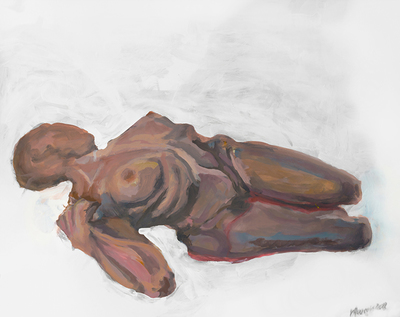Sale on canvas prints! Use code ABCXYZ at checkout for a special discount!

Welcome to another Art Blog. My name is Veronica Huacuja (wu-a-koo-ha). I'm a plastic artist, and an online art teacher. I’ve some good practical tips for your painting process.
LET’S TALK ABOUT SOMETHING IMPORTANT REGARDING OUR ART MATERIAL. Don’t throw away the artwork you consider at the moment unsatisfactory, because there’s still a good use for it. Let’s not throw away the paper or canvas on which the results were not what we expected. Let’s keep them and use them for a better achievement…, but this new use must be a strategic one. My recommendation for the new work is to leave some elements of the original work. This means, not cover with paint the whole original failed artwork, but to integrate it into the new one. This will improve the expression on our second try.
To exemplify the above, I add the data sheet of the work I’m presenting:
Title: Woman 10
Artist: Veronica Huacuja
Medium: Acrylic on paper
Size: 61 x 48.3 x 0.1 cm
Year: 2022
Collection: Women
Visit any time my patron's feed where you'll find images that describe the process of "Woman 10" using a failed painting on paper I made some time ago: https://www.patreon.com/posts/61243765
A SECONDARY TOPIC. I’d like to talk about the relevant use of physical models in our artwork. If, on the contrary, we use a photograph as an initial resource, we’d be working on the interpretation of another artist, in this case, the photographer (copying the gesture or other elements he already solved). And I add something relevant, we’d be working on a two dimensionality (height and width), not on a three dimensionality (height, width and depth). So, the recommendation is to use a physical model and to make our own interpretation out of it.
By doing the latter, we improve the coordination of our sight, brain activity and physical capacities (the hand skills). This training will help us achieve rhythm, dynamism, and gesture in our work.
MATERIAL.
- An unsatisfactory work on paper or canvas.
- Acrylics paintings.
- 3 brushes. The size of the paper or canvas determines the size of the brushes. When we paint on a small surface, the brushes must be small and vice versa. For this work, I used rectangular brushes less than an inch thick.
- Water.
Please write your opinions in the comment section. It will generate a very interesting dialogue.
Last, if you find this work interesting and helpful, please FOLLOW my FAA feed (https://veronica-huacuja.pixels.com). Thank you!
Visit any time:
My ART SHOP: https://veronica-huacuja.pixels.com
My BODY OF ART: https://veronica.mx
PHOTOS OF THE PROCEDURES of this artwork: https://www.patreon.com/posts/61243765
My ONLINE PAINTING COURSE in traditional or digital techniques: https://veronica.mx/online_painting_course
Thank you for visiting.